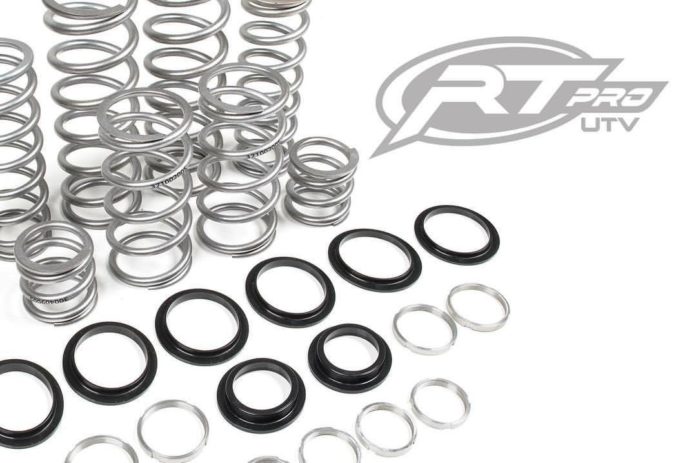There’s no debate about it. The most recent crop of UTVs on the market are the most capable and best performing UTVs ever built. Straight out of the box, offerings from Polaris and CanAm (among others) are impressive.
However, we can’t just leave our toys alone, so when the folks at RT Pro spoke to us about how much we were missing and how much better our machine could perform, we had to give them a try.
A Division of FOX and SportTruck USA, RT Pro is based out of Coldwater, Michigan and makes top quality made in the USA products using US materials and manufacturing for a wide variety of UTVs.
The company was founded as RacerTech back in 2006. For over a decade now they have pioneered the UTV industry with many firsts including upper shock relocation lift kits, HD tie rods, modular bumpers, roll cages, countless chassis gussets and
OEM replacement spring kits.
With a quick glance around forums and social media groups you will come across a common complaint about the Polaris RzR XP 1000 and Turbo. The upper springs are sagging from the factory and people are asking about swapping out their tender springs.
First a little tech for our readers. Many people think that because the RzR comes with an upper and lower spring from the factory that they are factory equipped dual rate spring setups. This is incorrect. There are multiple ways a coilover shock can be set up. The three most common configurations are linear rate, dual rate and progressive rate.
A progressive rate spring is a single coil spring that has multiple spring rates built into it. The most common configuration of a progressive rate spring is a dual rate spring. One part of the coil will take a specific amount of force to push it down while another part of the coil will take a different amount of force to cause it to deflect. As the lower weight rated coils collapse, the spring transitions to the heavier rate part of the spring. Progressive rate springs are easy to identify because one part of the coil will be closer together than another section of the spring.

A dual rate setup is different than a single progressive dual rate spring in that it uses two linear rate springs stacked on top of each other. The lower spring rate collapses with less force and the second spring is designed to deflect as your vehicle encounters heavier forces. This is very similar to the way a single progressive spring works, but with the added benefit of being able to fine tune your ride easier and with less cost.
A linear rate spring setup has one spring rate throughout the range of travel of the suspension. This is the most economical of the springs produced and what Polaris uses on their dual spring setup RzRs. So what is the top spring? It’s not actually designed as a tender spring, it is meant to work as a helper spring.

This brings us to the question of what is a helper spring? A helper spring is simply a coil that is designed to close completely at ride height and maintain a load on the main spring when the shocks are being extended. This prevents coil slap and the pressure of the coil spring helps prevent the main spring from rotating when properly adjusted.
Moving on to the reason we’re here. RT Pro makes a replacement spring kit for a wide variety of the most popular UTVs on the market. Not only that, but they also offer various rates depending on your riding style and weight of accessories you’ve added.
Installation is simple with most common tools and would take even a novice only a few hours including disassembling everything off your vehicle to prep the shocks for the new springs.
Once on the trails, the results were immediately apparent and the RzR felt like a completely different vehicle. The way the RzR soaked up the terrain was nothing short of amazing. Slow speed crawling in the rocks produced less body roll, high speed rough sections were soaked up like they weren’t even there and the RzR felt much more stable in cornering. We struggled to find anything deep enough to cause the shocks to bottom out.
Gaining even more confidence in the machine, we went out and hit some jumps. Hitting 60-80 feet, the landings were plush and we weren’t experiencing the bucking typical of the stock RzR setup. Even simply things like braking got an improvement. We didn’t feel nearly as much of the rear end lifting when hitting the brakes. Everything felt much more stable than ever before.
We can highly recommend the spring kit from RT Pro. At a fraction of the cost of re-valving and tuning shocks, these are the single most effective way to improve the performance and handling of your UTV on the market today.
Click here if you you would like more information or to purchase a set of RT Pro shocks for your UTV.


























[…] RT Pro’s spring kits have consistently been one of their top sellers over the years for good reason. Reviews from publications and consumers have always been outstanding, including our own previously published review. […]